Entry Database : PDB / ID : 3vrrTitle Crystal structure of the tyrosine kinase binding domain of Cbl-c (PL mutant) in complex with phospho-EGFR peptide Epidermal growth factor receptor Signal transduction protein CBL-C Keywords / / / / / / / / Function / homology Function Domain/homology Component
/ / / / / / / / / / / / / / / / / / / / / / / / / / / / / / / / / / / / / / / / / / / / / / / / / / / / / / / / / / / / / / / / / / / / / / / / / / / / / / / / / / / / / / / / / / / / / / / / / / / / / / / / / / / / / / / / / / / / / / / / / / / / / / / / / / / / / / / / / / / / / / / / / / / / / / / / / / / / / / / / / / / / / / / / / / / Biological species Homo sapiens (human)Method / / / / Resolution : 2 Å Authors Takeshita, K. / Tezuka, T. / Isozaki, Y. / Yamashita, E. / Suzuki, M. / Yamanashi, Y. / Yamamoto, T. / Nakagawa, A. Journal : J.Biochem. / Year : 2012Title : Structural flexibility regulates phosphopeptide-binding activity of the tyrosine kinase binding domain of Cbl-c.Authors : Takeshita, K. / Tezuka, T. / Isozaki, Y. / Yamashita, E. / Suzuki, M. / Kim, M. / Yamanashi, Y. / Yamamoto, T. / Nakagawa, A. History Deposition Apr 13, 2012 Deposition site / Processing site Revision 1.0 Mar 6, 2013 Provider / Type Revision 1.1 Oct 30, 2024 Group Data collection / Database references ... Data collection / Database references / Derived calculations / Structure summary Category chem_comp_atom / chem_comp_bond ... chem_comp_atom / chem_comp_bond / database_2 / pdbx_entry_details / pdbx_modification_feature / pdbx_struct_conn_angle / struct_conn / struct_ref_seq_dif / struct_site Item _database_2.pdbx_DOI / _database_2.pdbx_database_accession ... _database_2.pdbx_DOI / _database_2.pdbx_database_accession / _pdbx_struct_conn_angle.ptnr1_auth_comp_id / _pdbx_struct_conn_angle.ptnr1_auth_seq_id / _pdbx_struct_conn_angle.ptnr1_label_atom_id / _pdbx_struct_conn_angle.ptnr1_label_comp_id / _pdbx_struct_conn_angle.ptnr1_label_seq_id / _pdbx_struct_conn_angle.ptnr3_auth_comp_id / _pdbx_struct_conn_angle.ptnr3_auth_seq_id / _pdbx_struct_conn_angle.ptnr3_label_atom_id / _pdbx_struct_conn_angle.ptnr3_label_comp_id / _pdbx_struct_conn_angle.ptnr3_label_seq_id / _pdbx_struct_conn_angle.value / _struct_conn.pdbx_dist_value / _struct_conn.pdbx_leaving_atom_flag / _struct_conn.ptnr1_auth_comp_id / _struct_conn.ptnr1_auth_seq_id / _struct_conn.ptnr1_label_atom_id / _struct_conn.ptnr1_label_comp_id / _struct_conn.ptnr1_label_seq_id / _struct_ref_seq_dif.details / _struct_site.pdbx_auth_asym_id / _struct_site.pdbx_auth_comp_id / _struct_site.pdbx_auth_seq_id
Show all Show less
 Yorodumi
Yorodumi Open data
Open data Basic information
Basic information Components
Components Keywords
Keywords Function and homology information
Function and homology information Homo sapiens (human)
Homo sapiens (human) X-RAY DIFFRACTION /
X-RAY DIFFRACTION /  SYNCHROTRON /
SYNCHROTRON /  MOLECULAR REPLACEMENT /
MOLECULAR REPLACEMENT /  molecular replacement / Resolution: 2 Å
molecular replacement / Resolution: 2 Å  Authors
Authors Citation
Citation Journal: J.Biochem. / Year: 2012
Journal: J.Biochem. / Year: 2012 Structure visualization
Structure visualization Molmil
Molmil Jmol/JSmol
Jmol/JSmol Downloads & links
Downloads & links Download
Download 3vrr.cif.gz
3vrr.cif.gz PDBx/mmCIF format
PDBx/mmCIF format pdb3vrr.ent.gz
pdb3vrr.ent.gz PDB format
PDB format 3vrr.json.gz
3vrr.json.gz PDBx/mmJSON format
PDBx/mmJSON format Other downloads
Other downloads 3vrr_validation.pdf.gz
3vrr_validation.pdf.gz wwPDB validaton report
wwPDB validaton report 3vrr_full_validation.pdf.gz
3vrr_full_validation.pdf.gz 3vrr_validation.xml.gz
3vrr_validation.xml.gz 3vrr_validation.cif.gz
3vrr_validation.cif.gz https://data.pdbj.org/pub/pdb/validation_reports/vr/3vrr
https://data.pdbj.org/pub/pdb/validation_reports/vr/3vrr ftp://data.pdbj.org/pub/pdb/validation_reports/vr/3vrr
ftp://data.pdbj.org/pub/pdb/validation_reports/vr/3vrr Links
Links Assembly
Assembly
 Components
Components Homo sapiens (human) / Gene: CBLC / Plasmid: pGEX6p-1 / Production host:
Homo sapiens (human) / Gene: CBLC / Plasmid: pGEX6p-1 / Production host: 
 Homo sapiens (human)
Homo sapiens (human) X-RAY DIFFRACTION / Number of used crystals: 1
X-RAY DIFFRACTION / Number of used crystals: 1  Sample preparation
Sample preparation SYNCHROTRON / Site:
SYNCHROTRON / Site:  SPring-8
SPring-8  / Beamline: BL44XU / Wavelength: 0.9 Å
/ Beamline: BL44XU / Wavelength: 0.9 Å molecular replacement
molecular replacement Processing
Processing MOLECULAR REPLACEMENT / Resolution: 2→29.71 Å / Cor.coef. Fo:Fc: 0.946 / Cor.coef. Fo:Fc free: 0.92 / WRfactor Rfree: 0.226 / WRfactor Rwork: 0.182 / Occupancy max: 1 / Occupancy min: 0.5 / SU B: 3.826 / SU ML: 0.111 / Cross valid method: THROUGHOUT / σ(F): 0 / σ(I): 0 / ESU R: 0.21 / ESU R Free: 0.177 / Stereochemistry target values: MAXIMUM LIKELIHOOD
MOLECULAR REPLACEMENT / Resolution: 2→29.71 Å / Cor.coef. Fo:Fc: 0.946 / Cor.coef. Fo:Fc free: 0.92 / WRfactor Rfree: 0.226 / WRfactor Rwork: 0.182 / Occupancy max: 1 / Occupancy min: 0.5 / SU B: 3.826 / SU ML: 0.111 / Cross valid method: THROUGHOUT / σ(F): 0 / σ(I): 0 / ESU R: 0.21 / ESU R Free: 0.177 / Stereochemistry target values: MAXIMUM LIKELIHOOD Movie
Movie Controller
Controller


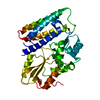

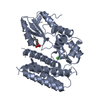
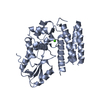
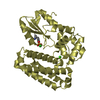
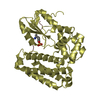
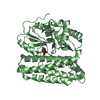
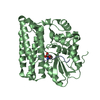
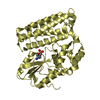

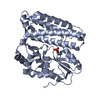

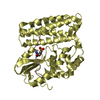
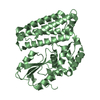
 PDBj
PDBj


















